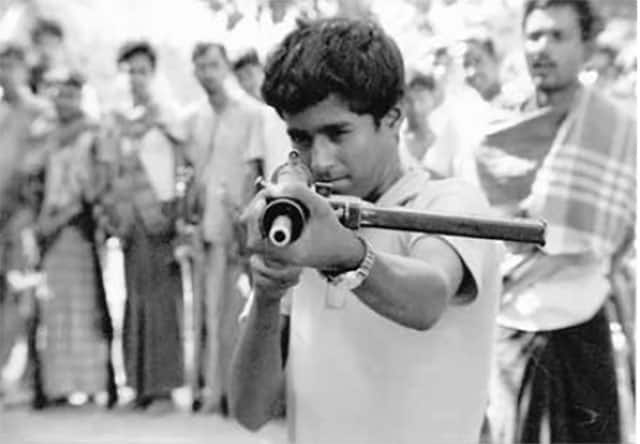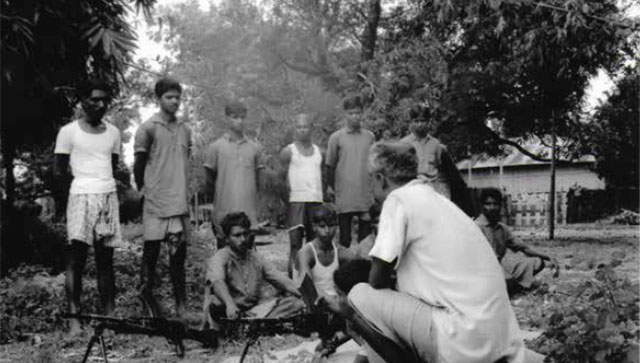Pakistan has always maintained that India commenced the 1971 war as early as November 1971 and this claim has not been without good reason. All accounts of the war from Pakistan, prominent among them being the ones written by Lt Gen Niazi and Shuja Nawaz clearly mark the beginning of the conflict with the deep forays by the Indian Army into East Pakistan in the Boyra and Belonia bulges on the western and eastern borders of East Pakistan. As early as September 1971, specialist counterinsurgency troops from an Indian Army Jat battalion (31 Jat) made deep forays into the Chittagong sector and ambushed a large Pakistan Army boat convoy, inflicted heavy casualties and then melted away into the jungle and returned to their home base in Tripura. Among the fiercest early encounters took place in late October 1971 in Lt Gen Sagat Singh’s 4 Corps sector around the picturesque tea estate of Dhalai. Located right on the border between the Indian state of Tripura and East Pakistan and about 35 km south-east of the important town of Maulvi Bazaar, the verdant gardens saw a pitched battle for over three days between 61 Brigade and 12 Frontier Force, a Pakistan Army battalion from 14 Division. After suffering a fair number of casualties following some stout resistance from the Frontier Force battalion, the tea estate was captured by the Indian Army and used as one of the many launch pads for the subsequent offensive. The scope of Indian military involvement increased substantially in the first three weeks of November 1971 but in most cases the Indian units would hit their objectives in East Pakistan and withdraw to Indian territory. After the night of 21 November, when prime minister Indira Gandhi gave a free hand to the Indian Army, the tactics changed in one significant way. Indian forces did not withdraw as several Indian Army battalions launched simultaneous military actions on all key border regions of East Pakistan from all directions. The first major attacks into East Pakistan by the Indian Army along with elements of the Mukti Bahini were launched on the night of 20/21 November along multiple ingress points as fierce brigade-level battles were fought at Boyra in the western sector, Hilli in the north-western sector, Akhaura in the eastern sector and Sylhet in the north-eastern sector. The Battle for Akhaura saw Sabres from 14 Squadron PAF, the only PAF squadron in East Pakistan, provide effective Close Air Support to Pakistan Army’s 27 Brigade. Since there was very little Indian radar cover in the area and the closest IAF airfields were over 130 miles away, intercepting these PAF missions proved to be difficult. It was only when IAF fighters started operating from Agartala, that Close Air Support for 4 Corps became easily available. Two brigades of the Indian Army’s 9th Division made significant progress towards Niazi’s fortress of Jessore by capturing a large enclave that comprised the forward defensive localities of Boyra and Garibpur by the end of November. [caption id=“attachment_13448842” align=“alignnone” width=“640”] (File) Training of Mukti Bahini. Image courtesy Air Vice Marshal Arjun Subramaniam[/caption] The curtain raiser for the air campaign also took place in this sector between Sabres of 14 Squadron, PAF and Gnats of 22 Squadron, IAF. The Gnats were operating a detachment at Dum Dum airport at Calcutta to provide air defence cover to the Indian Army as it carried out shallow thrusts into enemy territory. Alarmed at the success of the Indian Army’s incursions, PAF Sabres were called into action on 19 November to support a beleaguered 107 Brigade from the Pakistan Army, which was fighting a rearguard action around Boyra against two marauding Indian brigades. On 21 November, as the Pakistanis called upon the lone armoured squadron of approximately 14 Chaffee tanks along with repeated air strikes to throw back the numerically superior Indian forces. It was then that the IAF was finally called into action, much to the relief of Indian brigades under attack. Controlled by a radar unit located at Barrackpore, a few miles out of Calcutta, four Gnat fighters of 22 Squadron were ‘scrambled’ on two occasions - once in the morning and next in the evening – to try and intercept Sabres who were attacking the Indian brigades. Much to the frustration of the Gnats and the Indian brigades, the Sabres had vanished from the area by the time the IAF fighters arrived over Boyra. After another unsuccessful attempt on the morning of 22 November, the Indian finally drew blood in the afternoon thanks to some aggressive flying by a bunch of four ‘young guns’. In a classic aerial dogfight between two comparable machines, the IAF Gnats pounced on a careless bit of tactical flying on the part of the experienced PAF squadron commander who was leading his formation of three Sabres on a ground attack mission. While Wing Commander Chaudhry, the commanding officer of the squadron managed to get back unscathed, his two young formation members, including a future PAF air chief, were shot down by Flight Lieutenant Roy Massey and Flying Officers Lazarus, Ganapathy and Soares. Massey, Lazarus and Ganapathy were the IAF’s first Vir Chakra awardees of the conflict. This tactical engagement remains one of the most dissected aerial engagements of the 1971 war and numerous lessons were drawn from it. Covert operations by small teams of well-trained Mukti Bahini operatives caused mayhem within Pakistani ranks as they struck military targets at multiple locations. The contribution of the Mukti Bahini during the ‘shadow war’ was immense and their greatest contribution was in providing intelligence for manoeuvre. If the Indian Army had to manoeuvre in a vacuum in Bangladesh, it would have ended up waging attrition warfare like in the western sector. Instead, during the initial stages of the war, the Indian Army almost exactly knew where the enemy was thanks to the Mukti Bahini and later on, even if it did not, it could predict their moves thanks to the inputs given by the Mukti Bahini. For the first time after independence, ‘Shaping the battlefield’ was not just a term that Indian field commanders had talked about at their war colleges. They went about translating it into capture of vital ground in the sectors of its choice that would allow them to send in large forces when full-scale operations began after Pakistan ‘officially’ started the war on both fronts with their pre-emptive air strikes on multiple IAF airfields on 03 December 1971. The author is a retired fighter pilot who has flown both the MiG-21 and the Mirage 2000. He is also an air power analyst and military historian. Views expressed in the above piece are personal and solely that of the author. They do not necessarily reflect Firstpost’s views. Read all the
Latest News
,
Trending News
,
Cricket News
,
Bollywood News
, India News
and
Entertainment News
here. Follow us on
Facebook
,
Twitter
and
Instagram
.
(File) Training of Mukti Bahini. Image courtesy Air Vice Marshal Arjun Subramaniam[/caption] The curtain raiser for the air campaign also took place in this sector between Sabres of 14 Squadron, PAF and Gnats of 22 Squadron, IAF. The Gnats were operating a detachment at Dum Dum airport at Calcutta to provide air defence cover to the Indian Army as it carried out shallow thrusts into enemy territory. Alarmed at the success of the Indian Army’s incursions, PAF Sabres were called into action on 19 November to support a beleaguered 107 Brigade from the Pakistan Army, which was fighting a rearguard action around Boyra against two marauding Indian brigades. On 21 November, as the Pakistanis called upon the lone armoured squadron of approximately 14 Chaffee tanks along with repeated air strikes to throw back the numerically superior Indian forces. It was then that the IAF was finally called into action, much to the relief of Indian brigades under attack. Controlled by a radar unit located at Barrackpore, a few miles out of Calcutta, four Gnat fighters of 22 Squadron were ‘scrambled’ on two occasions - once in the morning and next in the evening – to try and intercept Sabres who were attacking the Indian brigades. Much to the frustration of the Gnats and the Indian brigades, the Sabres had vanished from the area by the time the IAF fighters arrived over Boyra. After another unsuccessful attempt on the morning of 22 November, the Indian finally drew blood in the afternoon thanks to some aggressive flying by a bunch of four ‘young guns’. In a classic aerial dogfight between two comparable machines, the IAF Gnats pounced on a careless bit of tactical flying on the part of the experienced PAF squadron commander who was leading his formation of three Sabres on a ground attack mission. While Wing Commander Chaudhry, the commanding officer of the squadron managed to get back unscathed, his two young formation members, including a future PAF air chief, were shot down by Flight Lieutenant Roy Massey and Flying Officers Lazarus, Ganapathy and Soares. Massey, Lazarus and Ganapathy were the IAF’s first Vir Chakra awardees of the conflict. This tactical engagement remains one of the most dissected aerial engagements of the 1971 war and numerous lessons were drawn from it. Covert operations by small teams of well-trained Mukti Bahini operatives caused mayhem within Pakistani ranks as they struck military targets at multiple locations. The contribution of the Mukti Bahini during the ‘shadow war’ was immense and their greatest contribution was in providing intelligence for manoeuvre. If the Indian Army had to manoeuvre in a vacuum in Bangladesh, it would have ended up waging attrition warfare like in the western sector. Instead, during the initial stages of the war, the Indian Army almost exactly knew where the enemy was thanks to the Mukti Bahini and later on, even if it did not, it could predict their moves thanks to the inputs given by the Mukti Bahini. For the first time after independence, ‘Shaping the battlefield’ was not just a term that Indian field commanders had talked about at their war colleges. They went about translating it into capture of vital ground in the sectors of its choice that would allow them to send in large forces when full-scale operations began after Pakistan ‘officially’ started the war on both fronts with their pre-emptive air strikes on multiple IAF airfields on 03 December 1971. The author is a retired fighter pilot who has flown both the MiG-21 and the Mirage 2000. He is also an air power analyst and military historian. Views expressed in the above piece are personal and solely that of the author. They do not necessarily reflect Firstpost’s views. Read all the
Latest News
,
Trending News
,
Cricket News
,
Bollywood News
, India News
and
Entertainment News
here. Follow us on
Facebook
,
Twitter
and
Instagram
.
War in Our Times | How Indian military shaped the battlefield in East Pakistan in 1971
Air Vice Marshal Arjun Subramaniam
• November 30, 2023, 16:21:25 IST
The scope of Indian military involvement increased substantially in the first three weeks of November 1971 but in most cases the Indian units would hit their objectives in East Pakistan and withdraw to Indian territory
Advertisement
)
End of Article